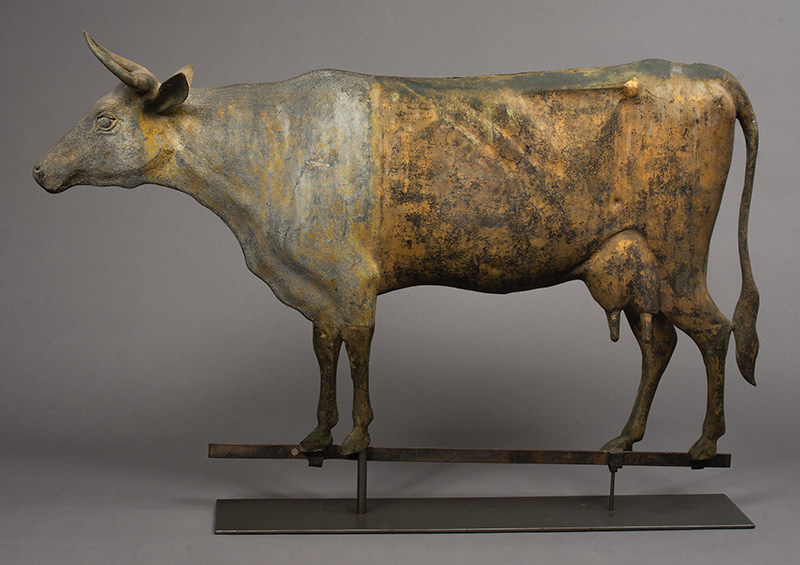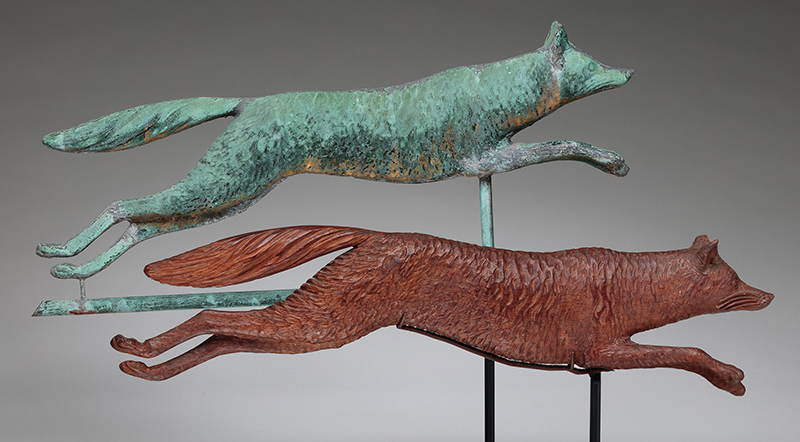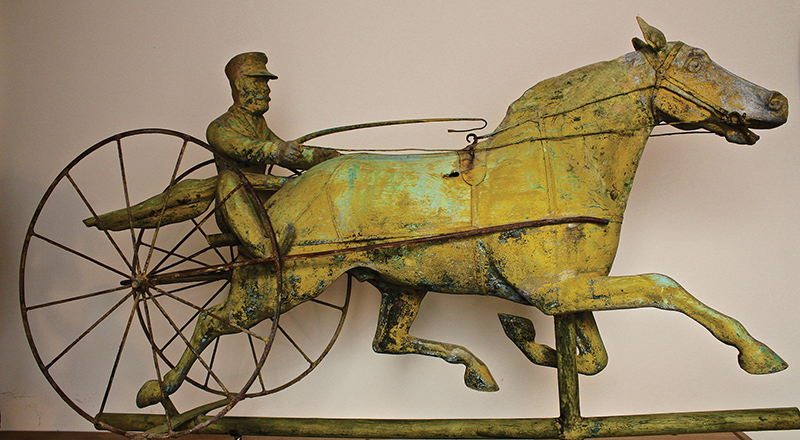Beneath the Surface: A Fresh Look at American Weathervanes
by Robert Shaw and Emelie Gevalt
On view at the American Folk Art Museum from June 23, 2021, to January 2, 2022, American Weathervanes: The Art of the Winds explores the rich layers of meaning behind a range of these evocative sculptural objects, crafted between the 1760s and 1914. In conjunction with the exhibition, an accompanying book by Robert Shaw documents the dynamic history of vanes in the British American colonies through their heyday in the 19th- and early-20th-century United States. Examined closely through the lenses of craftsmanship, surface analysis, and cultural history, weathervanes reveal their full biographies not only as tools but as works of art and symbols of identity. This article shares a glimpse of some of the research behind the objects gathered for the exhibition, looking especially at the vane-making process and the analysis of vane surfaces—aspects of weathervane history that have previously gone understudied.
Craftsmanship
In order to serve both functional and aesthetic purposes, weathervanes required careful design and construction. To face into the prevailing wind, their front ends needed to be heavy, while the lighter and broader back of the body caught the wind, allowing the vane to rotate freely. The cow weathervane (figure 1) reflects a common practice of using two different metals: sheet copper for the legs, rear body, ears, and tail, and cast zinc for the head and front torso. The weight differential gave the weathervanes their balance, with the heavier zinc components naturally rotating into the wind.
Although commercial weathervane makers often billed themselves as “manufacturers,” that term did not have the same meaning it does today, implying production by machine. Throughout their processes, carvers and metalsmiths worked by hand, and weathervanes of the 18th, 19th, and early 20th centuries often display high levels of craftsmanship. The earliest American vanes were unique, one-off objects, made by a variety of artisans including woodworkers and metalsmiths. In the 19th century, vane-making became more specialized, competition between manufacturers increased, and more elaborate vanes proliferated.
Beginning in the 1850s, companies engaged carvers to create solid-bodied wooden patterns for their vanes. Following in the tradition of other highly detailed carvings, including trade signs, shop figures, and ship figureheads, artists such as Harry Leach created detailed, life-like designs that served as prototypes (figure 2). Next, an iron founder would use the technique of sand casting to create reusable iron molds from the wooden pattern. These molds were negative mirrors of the pattern’s positive form. Vane makers then hammered sheets of copper into the iron molds to create the weathervane’s two-sided components. Finally, these pieces were soldered together, resulting in a hollow-bodied, often highly sculptural three-dimensional weathervane.
The Weathered Vane
Weathervane surfaces demonstrate differing histories of use, exposure, and care. Highly weathered copper vanes reacted to contact with the elements by taking on a velvety, mellow green patina, such as that seen in the Fox (figure 2). Other examples, like the gilded Goat vane (figure 3), have retained their golden hue through careful upkeep, showing their age through a variegated surface that gives the figure dimensionality and historical character. St. Julien with Sulky and Driver (figure 4), weathering has provided a window onto the vane finishing process: the original gilded surface of this vane has worn away over time, revealing a layer of yellow sizing, originally applied as an underlayer to affix a final surface of lustrous gold leaf.
Weathervanes were commonly resurfaced to refresh their appearance following years of exposure to the elements, including sun, wind, soot, and precipitation. Typically, the older layers were covered over (rather than being stripped down) before regilding or painting. Careful scientific analysis can therefore lead to a greater understanding of an individual weathervane’s history. Microscopic samples taken from the Goat and Archangel Gabriel vanes (figures 3 and 5) were examined by conservation scientist Dr. Jennifer Mass, revealing multiple layers that remain intact beneath the current surface.1
Analysis of the Goat’s surface shows that it was gilded at least four times. Between re-paintings of the Archangel Gabriel’s sheet metal surface, the artist seems to have prepared the surface with a coat of white primer, a practice that would have extended the longevity of the finish. These results chart a history of use that speaks to the weathervanes’ ongoing functionality and importance to their owners. A final highlight from the show, The Portland Rooster is a rare wooden 18th-century weathervane that survives as a testament to these objects’ enduring meaning and beauty, whether they continue to function as working vanes or occupy places of pride in collections of art and antiques.
1 The research on these vanes is discussed in a chapter by Dr. Jennifer Mass in the book American Weathervanes: The Art of the Winds. The publication also includes a full chapter on the materials and processes of weathervane making.
Robert Shaw is an art historian and independent curator. Emelie Gevalt is the Curator of Folk Art at the American Folk Art Museum. Shaw is the guest curator and Gevalt is the coordinating curator of the exhibition American Weathervanes: The Art of the Winds.
A print version of this article was published in The Magazine of the Decorative Arts Trust, one of our most popular member benefits. Join today!






